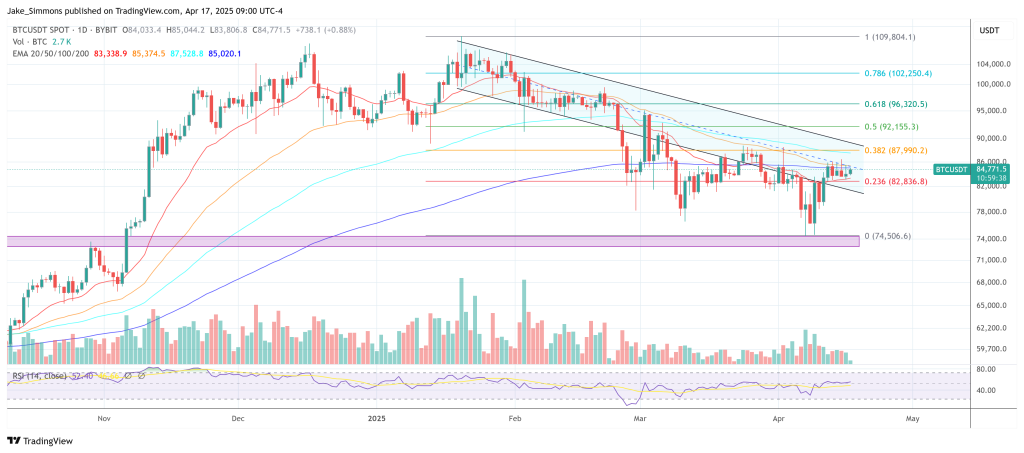[ad_1]

A quantum‑computing collective referred to as Undertaking Eleven has thrown down a public gauntlet to the worldwide cryptography group, providing a reward of 1 Bitcoin to the primary crew that may break a intentionally down‑scaled model of Bitcoin’s elliptic‑curve cryptography utilizing a real quantum laptop earlier than 5 April 2026.
Asserting what it calls the “Q‑Day Prize” on X, the group wrote: “We simply launched the Q‑Day Prize. 1 BTC to the primary crew to interrupt a toy model of Bitcoin’s cryptography utilizing a quantum laptop. Deadline: April 5, 2026. Mission: Defend 6 M BTC (over $500 B).” The publish crystallises a priority that has hovered over the Bitcoin ecosystem for greater than a decade: the eventual arrival of huge‑scale, error‑corrected quantum {hardware} able to operating Shor’s algorithm towards actual‑world keys.
Undertaking Eleven just isn’t asking contestants to shatter Bitcoin’s 256‑bit curve instantly. As a substitute, groups should display Shor’s algorithm towards elliptic‑curve keys starting from one to twenty‑5 bits—sizes derisively referred to as “toy” by skilled cryptographers however nonetheless orders of magnitude past what has been publicly achieved on bodily quantum processors. The organisers argue that even a 3‑bit break could be “massive information,” as a result of it will present the primary quantitatively verifiable benchmark of quantum progress on the elliptic‑curve discrete‑log drawback (ECDLP). Of their phrases, “No person has rigorously benchmarked this menace but.”
To qualify, a submission should embody gate‑stage code or specific directions runnable on precise quantum {hardware}, together with a story of strategies employed, error‑charges managed and the classical publish‑processing required. Hybrid assaults that lean on classical shortcuts are disallowed. All entries might be revealed, a choice the group frames as an train in radical transparency: “As a substitute of ready for breakthroughs to occur behind closed doorways, we imagine in dealing with this problem head‑on, in a clear and rigorous method.”
Why 1 Bitcoin—And Why Now?
Bitcoin’s safety finally rests on the hardness of the discrete‑logarithm drawback over the secp256k1 curve. Whereas classical assaults scale exponentially, Peter Shor’s 1994 quantum algorithm may in precept remedy the issue in polynomial time, collapsing the associated fee from cosmic to merely gargantuan. Present analysis estimates that on the order of two thousand absolutely error‑corrected logical qubits—maybe backed by hundreds of thousands of bodily qubits—could be ample to threaten a 256‑bit key. Firms such as Google, IBM, IonQ and newcomer QuEra are racing to cross the 4‑digit logical‑qubit threshold, although none has publicly demonstrated something near that functionality immediately.
Undertaking Eleven says its prize is meant much less as a bounty and extra as a diagnostic. Greater than ten million Bitcoin addresses, holding over six million cash, have already uncovered their public keys by prior spending exercise. If quantum expertise crosses the vital threshold earlier than these cash are migrated to publish‑quantum addresses, the funds could be weak to instant theft. “Quantum computing is steadily progressing,” the group warns. “When that occurs, we have to know.”
The initiative lands amid a flurry of quantum‑resilience proposals throughout the wider Bitcoin ecosystem. Earlier this month, a bunch of builders submitted the Quantum‑Resistant Handle Migration Protocol (QRAMP), a Bitcoin Enchancment Proposal that may orchestrate a community‑vast transfer to publish‑quantum key codecs. As a result of QRAMP would require a consensus‑breaking arduous fork, its political prospects stay unsure.
Individually, Canadian startup BTQ has pitched an unique proof‑of‑work different referred to as Coarse‑Grained Boson Sampling, which might substitute immediately’s hash‑based mostly mining puzzles with photonic sampling duties executed on quantum {hardware}. Like QRAMP, BTQ’s idea calls for a tough fork and has but to garner broad help.
From a technical standpoint, operating even a 5‑bit elliptic‑curve model of Shor’s algorithm is brutally unforgiving: qubits with fidelities above 99.9 %, coherent for a whole lot of microseconds, and orchestrated by deep circuits numbering within the hundreds of two‑qubit gates could be required. Error‑correction overhead additional compounds the engineering burden, which means that contenders will probably need to make use of small‑code logical qubits and spectacular compilation strategies merely to maintain noise below management.
But the prize could show irresistible for college labs and company R&D groups wanting to display sensible quantum benefit. Cloud‑accessible units from IBM’s Quantum System Two, Quantinuum’s H‑sequence and OQC’s superconducting platforms already permit restricted, pay‑per‑shot entry to dozens—or in IBM’s case, a whole lot—of bodily qubits. Whether or not any of these machines can maintain the circuit depth needed stays to be seen.
Both end result provides invaluable information. Within the phrases of Undertaking Eleven’s launch tweet, the target is stark: “Break the most important ECC key with Shor’s algorithm. The reward: 1 BTC + go down in cryptography historical past.”
At press time, BTC traded at $84,771.

Featured picture created with DALL.E, chart from TradingView.com

Editorial Course of for bitcoinist is centered on delivering completely researched, correct, and unbiased content material. We uphold strict sourcing requirements, and every web page undergoes diligent overview by our crew of prime expertise specialists and seasoned editors. This course of ensures the integrity, relevance, and worth of our content material for our readers.
[ad_2]
Source link


